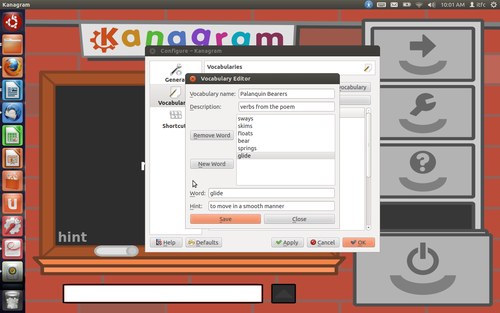Difference between revisions of "The Village School Master"
| Line 9: | Line 9: | ||
== Text of the poem == | == Text of the poem == | ||
| + | '''The Village School Master by Oliver Goldsmith.''' | ||
| − | + | Click [http://allpoetry.com/poem/8460787-The-Village-Schoolmaster-wbr--by-Oliver-Goldsmith here] to access the text of the poem. | |
== Idea of the poem == | == Idea of the poem == | ||
Revision as of 05:56, 2 June 2014
Introduction
Concept Map
Text of the poem
The Village School Master by Oliver Goldsmith.
Click here to access the text of the poem.
Idea of the poem
Core Meaning
Alternative interpretations
Context of the poem
About the author
Transacting the text
Audio recital of the poem
Language appreciation
Meaning making
Vocabulary
New words in a poem can be introduced through interactive educational tools. Tools such as Kanagram allow you to create vocabulary lists which can be introduced to the students. Students can also assist teachers in building these vocabularies. To learn how to use Kanagram and Khangman (UBUNTU Educational tools) please visit the following link:
Sample
word list created on Kanagram:
Palanquin
Bearers: Verbs from the poem
Sways: Move from side to side
Skims:
To move quickly
Floats:
To remain on surface without sinking
Bear:
To hold
Springs:
To move quickly
Glide:
To move in a smooth manner

Word list created on
Kanagram can be accessed from Khangman
For more information on vocabulary visit: http://karnatakaeducation.org.in/KOER/index.php/Vocabulary/Grammar
Figures of speech
A figure of speech is the use of a word or words diverging from its usual meaning. It can also be a special repetition, arrangement or omission of words with literal meaning, or a phrase with a specialized meaning not based on the literal meaning of the words in it, as in idiom, metaphor, simile, hyperbole, or personification. Figures of speech often provide emphasis, freshness of expression, or clarity. However, clarity may also suffer from their use, as any figure of speech introduces an ambiguity between literal and figurative interpretation. A figure of speech is sometimes called a rhetorical figure or a locution. To know more click http://en.wikipedia.org/wiki/Figure_of_speech
The ones which have been used in this poem are:
- Similes – It is a figure of speech which directly compares two things. It can use words such as 'like', 'as', 'than' etc. to convey the comparison.
Use of
similes in the poem:
- We bear her along like a pearl on a string - Movement of a pearl on a string.
- She falls like a tear - Dripping movement of the tear.
- She springs like a beam - Quick movement of the ray of light.
- She hangs like a star - Movement of a star that twinkles in the sky.
- She sways like a flower - Swaying of a lovely flower in the wind.
- She skims like a bird - Gliding movement of the bird flying over a stream.
- She floats like laugh - Floating like a sweet smile on the lips of a dreamer.
- Alliteration – Repetition of a particular sound in the prominent lifts of a series of words. It is mainly used in poems.
Use of
alliteration in the poem:
- She – sways
- She – skims
- Like – laugh – lips
- Gaily – glide
- Beam – brown
- Musical effect:-
Gaily O’ Gaily
Light O’ light
Softly
O’ softly
Additional resources
Videos can be used in the classroom to demonstrate effective reading strategies. A poem can be read out with emotions, voice modulation and dramatic effects by the teacher. Some poem recitations are available over the Internet too. A few links to the same are:
http://www.youtube.com/watch?v=evvX4oVAV1g/
Assessment
Ask the learners to write a short paragraph using the hints given below.
Hints:
- What is the poem about?
- Which is the most striking image and why.?
- What are the similarities and differences between the present marriage system and the one described in the poem?
